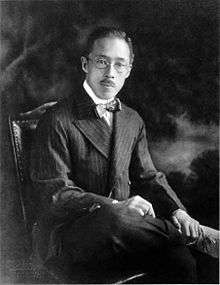Iemasa Tokugawa
Prince Iemasa Tokugawa (徳川 家正, Tokugawa Iemasa, March 23, 1884 – February 18, 1963) also known as Iyemasa, was a Japanese political figure of the Taishō and early Shōwa periods. He was the 17th hereditary head of the former shogunal branch of the Tokugawa clan and the final President of the House of Peers in the Diet of Japan.
Iemasa Tokugawa | |
|---|---|
| Born | March 23, 1884 Tokyo, Japan |
| Died | February 18, 1963 (aged 78) |
| Title | Prince, Head of the Tokugawa clan |
| Spouse(s) | Naoko Shimazu |
| Children | Iehide Tokugawa Toyoko Tokugawa |

Biography
Iemasa Tokugawa was born in what is now the Sendagaya district of Tokyo, as the eldest son of Tokugawa Iesato and his wife, Konoe Hiroko, daughter of Konoe Tadafusa. He graduated from the law school of Tokyo Imperial University in 1909, and accepted a post in the diplomatic corps of Foreign Ministry the same year. In 1924, he was appointed Consul-general to the Japanese consulate in Sydney, Australia. In 1929, he was appointed Envoy to Canada and from 1937 to 1939 served as the Japanese ambassador to Turkey.[1]
Iemasa often allied with his father Prince Tokugawa Iesato (aka Prince Iyesato Tokugawa) in promoting international goodwill projects between Japan and Europe, Canada, and United States. The Art of Peace book cover photo illustration at the right presents Iemasa accompanying his father, as his father receives an honorary doctor of laws degree from the president of the University of Southern California in 1934. During that same year, on May 10th, 1934, Iyemasa was also recognized for his humanitarian and goodwill diplomatic efforts by a prominent North American University and was given an honorary doctor of laws degree from the University of British Columbia in Canada.[2]
In 1940, on the death of his father, he inherited the title of kōshaku (公爵, "prince") under the kazoku peerage system, and a seat as a member of the House of Peers of the Diet of Japan. On June 19, 1946, he served as the President of the House of Peers, a post which he held until May 2, 1947, when the Allied occupation authorities authorized the current Constitution of Japan abolishing the House of Peers.
He died of heart disease at his home in Shibuya, Tokyo, on February 18, 1963, and was posthumously awarded the Order of the Rising Sun with Paulownia Flowers, 1st class. His grave is located at the Yanaka Cemetery in Tokyo. He was succeeded as head of the Tokugawa clan by Tsunenari Tokugawa, his grandson from Yasuko Tokugawa with Matsudaira Ichiro, son of Tsuneo Matsudaira.
Family
- Father: Tokugawa Iesato
- Mother: Konoe Hiroko (1867-1944)
- Wife: Naoko Shimazu
- Children
- Iehide Tokugawa (1912-1936)
- Toyoko Tokugawa married Ichiro Matsudaira, son of Tsuneo Matsudaira
- Toshiko Tokugawa married Uesugi Takanori
- Junko Tokugawa married Hoshina Mitsumasa
- Grandchild:
- Tsunenari Tokugawa from Toyoko Tokugawa
References
- Aydin, Cemil (2005). "Orientalism by the Orientals? The Japanese Empire and Islamic Studies (1931-1945)" (PDF). www.isam.org.tr/.
- Katz, Stan S. (2019). The Art of Peace illustrated biography on Prince Tokugawa. California: Horizon Productions. ISBN 978-0-9903349-2-7.
- Banno, Junji. The Establishment of the Japanese Constitutional System. Routledge (1992). ISBN 0-415-00497-7
- Lebra, Sugiyama Takie. Above the Clouds: Status Culture of the Modern Japanese Nobility. University of California Press (1995). ISBN 0-520-07602-8
- Sims, Richard. Japanese Political History Since the Meiji Renovation 1868–2000. Palgrave Macmillan. ISBN 0-312-23915-7
External links
- Yanaka Cemetery (Japanese)
- Introduction to an illustrated biography titled The Art of Peace that highlights Prince Iyesato Tokugawa and his son Iemasa Tokugawa [1]

- Katz, Stan S. (October 2019). "The Art of Peace biography honors Prince Iyesato Tokugawa and his son Iemasa Tokugawa". TheEmperorAndTheSpy.com.